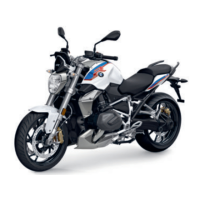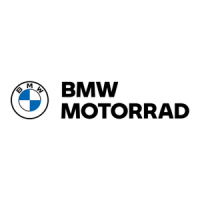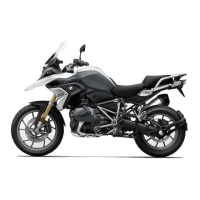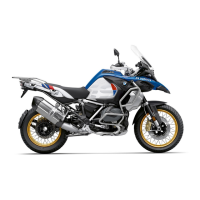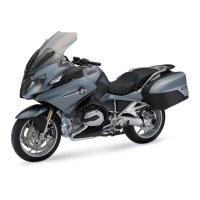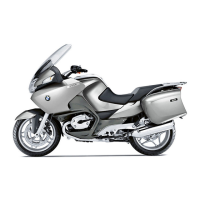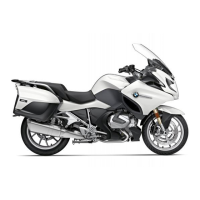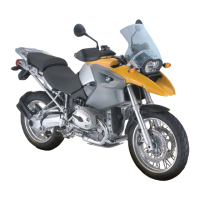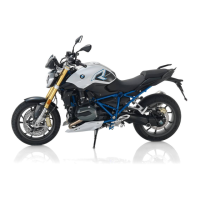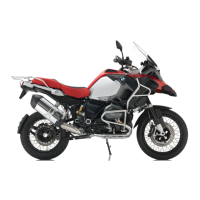Do you have a question about the BMW Motorrad R 1250 RT and is the answer not in the manual?
Provides an overview of the manual's content and purpose.
Offers a quick overview and reference to motorcycle sections.
Explains common abbreviations and symbols used in the manual.
Details custom equipment options and their descriptions in the manual.
Provides dimensions, weights, and power ratings according to standards.
Notes that motorcycle may differ from manual due to continuous development.
Lists authorized retailers and the internet as sources for more information.
Mentions downloading vehicle certificates and operating licenses from the BMW Motorrad website.
Explains control units and data processing within the vehicle.
Details the principle, legal basis, SIM card, improving quality, and location determination of the emergency call system.
Illustrates and labels various components visible from the left side of the motorcycle.
Illustrates and labels various components visible from the right side of the motorcycle.
Provides a labeled diagram of the motorcycle's cockpit controls and displays.
Shows and labels components located beneath the rider's seat.
Details the functions and labeling of the controls on the left handlebar switch.
Details the functions and labeling of the controls on the right handlebar switch.
Identifies and explains the indicators and displays on the motorcycle's instrument cluster.
Explains the various indicator and warning lights on the motorcycle's display and dashboard.
Describes the layout and meaning of the information displayed in the Pure Ride view.
Details the layout and meaning of the information displayed in the Menu view.
Explains the mode of presentation and meaning of various warning indicators and symbols.
Details the meaning of different symbols and numerical values displayed on the screen.
Explains how the color of symbols indicates the urgency of a warning or the status of a value.
Explains the operation of the ignition switch, steering lock, and the vehicle keys.
Details the operation of starting and switching off the ignition using the keyless ride system.
Explains the function and operation of the emergency-off switch.
Describes how to make emergency calls via BMW and the system's behavior.
Covers the operation of side lights, low-beam, high-beam, and courtesy delay features.
Explains how to switch the DTC function on and off and its engineering details.
Details the possibilities for adjustment, damping modes, and load settings for the D-ESA system.
Explains the available riding modes and how to select them.
Describes how to switch on and operate the adaptive cruise control system.
Explains the ACC system, its control functions, and limits.
Details the operation, activation, and deactivation of the Hill Start Control system.
Covers the activation and deactivation of the anti-theft alarm system.
Explains how to switch the target-pressure warning on or off for the RDC system.
Describes the operation of heated handlebar grips and seat heating.
Details how to use the left and right storage compartments.
Explains the locking and unlocking procedures for the central locking system.
Covers the opening and closing procedures for the motorcycle's cases.
Provides warnings and general information regarding smartphone usage and connectivity.
Explains the basic controls and functions of the TFT display, including the Multi-Controller.
Describes the Rev. counter and Range display in the Pure Ride view.
Explains how to switch the splitscreen display on and off and select different views.
Covers adjusting volume, setting date, time, format, units, and language.
Details short-range wireless technology, possible interference sources, and pairing procedures.
Explains the function of WiFi connection for map view transmission.
Details the start screen of the My Vehicle menu and its components.
Explains how to call up and reset the on-board computer and trip computer functions.
Covers warnings, preconditions, showing map view, and entering destination addresses.
Explains how to control music playback and adjust audio settings.
Details telephone call handling, muting, and managing multiple participants.
Explains the operation and assignment of the favourite buttons.
Describes how to navigate to view the software version.
Explains how to navigate to view license information.
Covers starting the radio, switching it on/off, selecting source and station, and selecting frequency.
Explains settings for speakers, Bluetooth, and adjusting volume.
Details status indicators on the display and how to change stations or frequencies.
Information on availability, subscribing to channels, and activating channels.
Explains how to adjust volume for rider's helmet audio playback.
Explains how to adjust the mirrors.
Covers adjusting headlight beam throw and spring preload.
Details how to adjust the windscreen's position and its automatic functions.
Explains how to adjust the clutch lever.
Covers adjusting the handbrake lever.
Describes the process of removing and installing the rider's and passenger's seats.
Explains how to adjust the spring preload for the rear wheel based on load.
Details how to adjust the rear suspension damping characteristic.
Covers essential rider's equipment and warnings related to loading and riding conditions.
Provides a checklist for regular checks to be performed on the motorcycle.
Explains the procedure for starting the engine and the pre-ride check.
Guides on the engine running-in procedure, speeds, and checks.
Details the gear shift assistant and the shifting process.
Explains how to minimise stopping distance and warnings related to braking.
Provides instructions on parking the motorcycle, including using the side stand and centre stand.
Covers fuel grade recommendations and the refuelling process, including warnings.
Details how to properly secure the motorcycle for transportation to prevent damage.
Directs users to the BMW Motorrad website for more engineering information.
Explains how integral ABS works, rider feedback, and the effects of surface irregularities.
Details how DTC works, special situations, and its influence on performance.
Explains the purpose and function of dynamic engine brake control.
Explains what ACC is, how it works, its control functions, limits, and influence on performance.
Details the riding position equalizer and possibilities for adjustment in damping modes and load settings.
Explains the selection of riding modes (ECO, RAIN, ROAD, DYNAMIC) and their corresponding settings.
Explains the function and behavior of dynamic brake control in various situations.
Describes the function of the RDC system and how it measures tyre pressure.
Explains the Gear Shift Assistant Pro system, its advantages, and how it works.
Details the function, effect of incline, and behavior of the Hill Start Control system.
Explains the functional principle of the ShiftCam technology.
Describes how the adaptive cornering headlight system works.
Describes straightforward procedures for checking and replacing wear parts.
Lists the contents of the standard toolkit and their uses.
Mentions the availability of a special service toolkit from authorized retailers.
Details the process of removing and installing the spring-strut cover.
Explains the correct procedure for installing the front-wheel stand.
Covers checking and topping up engine oil levels, with warnings about misinterpretation.
Explains how to check the function of brakes and brake pad thickness.
Details checking the clutch function.
Covers checking and topping up the coolant level.
Provides tyre recommendations and checks for tyre pressures and tread depth.
Explains how to check the wheel rims for defects.
Discusses the effect of wheel size on chassis and suspension control systems.
Details how to pivot the silencer outwards.
Explains how to replace LED light sources.
Provides instructions and warnings for jump-starting the motorcycle.
Covers battery maintenance, charging, and handling precautions.
Explains how to replace fuses and provides a fuse assignment diagram.
Details how to disengage the diagnostic socket and secure it.
Advises on using genuine BMW parts and accessories and compliance with regulations.
Explains how to connect electrical devices to the motorcycle's sockets and cable routing.
Covers opening and closing the topcase.
Directs users to the BMW Motorrad website for optional accessories and lists maximum payload/speed.
Recommends using BMW cleaning and care products and provides warnings about unsuitable ones.
Provides instructions on how to wash the motorcycle, including removing dirt and road salt.
Details cleaning procedures for plastics, trim panels, windscreens, and headlight lenses.
Explains how to wash the vehicle to protect the paint from long-term effects of substances.
Recommends products for paint preservation when water no longer rolls off.
Provides instructions on preparing the motorcycle for storage, including fuel and battery care.
Outlines steps for bringing the motorcycle back into use after storage.
Lists common problems and their possible causes and rectification steps.
Provides tightening torque values for various fasteners on the front and rear wheels.
Details recommended and alternative fuel grades, usable fuel capacity, and reserve fuel.
Specifies engine oil capacity, specification, and topping up quantity.
Provides details on engine number location, type, design, displacement, bore, stroke, and compression ratio.
Specifies the clutch type.
Details the type of transmission and gearbox ratios.
Provides information on the type and gear ratio of the final drive.
Details frame type and plate location.
Describes the front and rear suspension types, design, and spring travel.
Details front and rear brake types, pad material, disc thickness, and play.
Provides recommended tyre combinations, speed categories, front/rear wheel types, rim sizes, and load indexes.
Lists electrical ratings for sockets, fuse assignments, battery specifications, and spark plugs.
Provides activation time and alarm duration for the anti-theft alarm.
Lists the overall dimensions of the motorcycle, including height with different windscreens and rider seats.
Specifies vehicle kerb weight, permissible gross weight, maximum payload, and payload per case/topcase.
Details top speed, maximum speed for riding with loaded cases and topcase.
Lists the available wavebands for the radio.
Provides technical specifications for the speakers.
Explains how to report safety-related defects to NHTSA and Transport Canada.
Highlights the extensive network of retailers and technical expertise for maintenance and repair.
Explains the entries in the proof of maintenance and electronic service booklet.
Informs about available mobility services like breakdown assistance.
Details the BMW pre-delivery check and the running-in check.
Explains the annual service schedule and how riders covering long distances might need earlier service.
Provides a detailed schedule of maintenance tasks based on mileage or time intervals.
Lists the repair tasks included in the standard BMW Service scope.
A table to verify maintenance, repair work, and optional accessories.
| Displacement | 1, 254 cc |
|---|---|
| Fuel System | Electronic Fuel Injection |
| Fuel Type | Premium unleaded |
| Tire, Front | 120/70 ZR17 |
| Tire, Rear | 180/55 ZR17 |
| Weight, Wet | 279 kg |
| Dry weight | 249 kg |
| Power | 136 hp (100 kW) at 7, 750 rpm |
| Torque | 143 Nm at 6, 250 rpm |
| Transmission | 6-speed constant mesh gearbox with helical gear teeth |
| Front Suspension | BMW Motorrad Telelever, central spring strut |
| Rear Suspension | BMW Motorrad Paralever |
| Front Brakes | Dual 320 mm |
| Rear Brakes | Single 276 mm disc, 2-piston floating caliper |
| ABS | Yes, BMW Motorrad Integral ABS |
| Length | 2222 mm |
| Width | 985 mm |
| Height | 1, 430 mm |
| Seat Height | 805 mm |
| Fuel Capacity | 25 L |
| Engine Type | Air/liquid-cooled flat twin (Boxer), 4-stroke, four valves per cylinder, double overhead camshafts, variable engine timing system BMW ShiftCam |
| Wheelbase | 1, 485 mm (58.5 in) |
